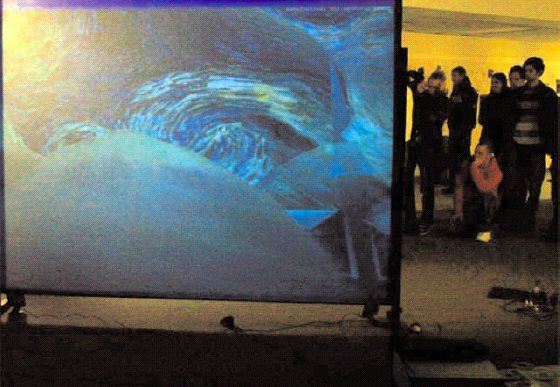This
special issue of Intelligent Agent presents six essays that explore
the aesthetics connected with virtual environments created and presented
as works of art, works about art, or related genres. The essays primarily
focus on the aesthetic experience for participants (AKA, the aesthetic
experience), aesthetic analysis, content, emotional content, emotional
experiences, and the unique, if any, qualities of the medium. |
|
Two of the essays
address emotion both as part of the experience for the participant
and as part of the content of the artistic virtual environment (AVE).
In "The Aesthetic Experience, Emotion and an Artistic Virtual
Environment," Dena Eber, Greg Little, and Brian Betz explore
the aesthetic experience for participants interacting with artistic
virtual environments (AVEs). Where other authors muse about the
effect of different theories on the aesthetic, this paper presents
a formal study that measures the experience using the emotional
response of participants. The response, if emotional, also gauges
the perceived emotional content of the AVE. The authors examine
if this kind of content coupled with the immersive qualities of
the AVE facilitates a rich aesthetic experience and thus a high
feeling of presence for the participant.
Emotion
is a crucial component of Josephine Anstey's "Agents in Love.
On the Construction and Use of Emotional Characters in VR,"
in which she discusses her approach to interactive drama that provides
an "emotional terrain" for the participants to discover.
Her stated goal is to put the participant in the role of the primary
character in a drama, one that unfolds through participation. Thus,
the participation is meant to bring forth an emotional response.
She states that this response is best elicited by employing two
key components, the application of dramatic tools for narrative
media to immersive virtual environments and the use of artificial
intelligent agent-actors that guide participants. Not only does
this essay focus on the emotional reaction of the human actor, but
it does so from a theoretical base developed for film and story.
Anstey applies ideas similar to Alfred Hitchcock's psychological
approach to a scripting process in which the theme centers on anxiety
and emotional tension. The participant experiences an "emotional
rollercoaster" and acts as a peer to the other actor-agents
in the drama, thus becoming a co-creator of the story. The drama
incorporates scenes that serve to provide structure to the story,
but also allow interaction. The actor-agents subtly guide the participant
through choices in the narrative and stimulate emotional responses
from the participant in an indirect way.
|
It
is clear that other time-based media, such as theater, film, and
narrative, provide the springboard for appreciating virtual environments.
While some theorists look to cognitive groundings, others seek to
redefine that frame and put forth a new classification. |
A
number of other works use film, theater, and story as a theoretical
frame to reflect on the aesthetic content and experience of AVEs.
In "Cognitive Schemas and Virtual Reality," Alison McMahan
and Warren Buckland argue how cognitive-semiotic theories from film
can be applied to virtual environments. In particular, they look
at how a viewer understands spatial orientation within the context
of a film. They discuss Buckland's Imagined Observer Hypothesis,
which articulates the idea that the viewer needs to feel that they
are "inside the fiction" in order to respond emotionally.
In VR, participants use a similar notion to orient themselves. The
authors present a number of cognitive schema theories that explain
corporeal understanding in virtual environments such as kinesthetic
image schemas, which says that perceptions are based on experience
from bodily sensory-motor inputs. The authors use another theory,
the container schema, to draw a parallel between body awareness
and immersive VEs such as the CAVE. They ultimately present the
groundwork for further research into whether or not these ideas
are indeed a model for the aesthetic experience for participants
in an AVE.
Film and theater
also inform Magy Seif El-Nasr's essay "Applying Principles
from Performance Arts for an Interactive Aesthetic Experience."
El-Nasr suggests that heightening tension and drama intensify involvement
and engagement for participants in a VE. The author uses acting
and screenwriting theories to put forth new methods for creating
VEs, including a multi-agent interactive drama approach. These are
meant to increase the dramatic effect for the participant, thus
initiating a richer experience.
The final two
essays deal predominantly with aesthetic analysis connected with
the aesthetic experience in AVEs. In "Building a Bridge to
the Aesthetic Experience: Artistic Virtual Environments and Other
Interactive Digital Art," Toby Crocket proposes the aesthetics
of play and empathy, a new criterion for understanding artistic
virtual environments, especially in light of their novelty. The
empathy component is grounded in the awareness that the participant
is not totally certain which avatar represents her, thus melding
her into a group identity and forging an opportunity for empathy.
The play element
includes the impression one gets from author chats, or a series
of CyberForums in which the authorship is de-centralized and a form
of controlled chaos emerges. This is a kind of playfulness that
encompasses discovery and encourages pleasure and a kind of flow
for the participant. Taken together, play and empathy provide a
framework for considering the aesthetics of virtual environments
as an art form.
In "Considerations
of the Corporeal: Moving From the Sensorial to the Social Body in
Virtual Aesthetic Experience," Juliet Davis highlights the
often overlooked qualitative differences between physical sensations
in real life and those of a virtual space. Among other theories,
she mentions Francisco Varela's "The Reenchantment of the Concrete"
in which he argues that cognition is grounded in embodied experience.
She then presents Diane Gromala's artwork The MeatBook, which is
grounded in Varela's theory. Davis mentions a number of other artists
and theorists who ultimately move the discussion into the social
and cultural realm. Thus, she suggests that in exploring an aesthetic
experience with this kind of media, we need to consider "the
nature of corporeality and materiality in lived interaction,"
which goes beyond experiences such as perception and cognition.
This series
of essays sheds interesting perspectives on how to negotiate, understand,
and ground some of the emerging components of AVEs, especially the
aesthetic experience for the participant. It is clear that other
time-based media, such as theater, film, and narrative, provide
the springboard for appreciating this art form. While some theorists
look to cognitive groundings, others seek to redefine that frame
and put forth a new classification. All but one of the writings
are theoretical, which identifies the need to further research the
experience that participants have with the VE art form. Perhaps
this grouping of manuscripts will prompt further exploration and
help provide fodder for further inquiry. |


